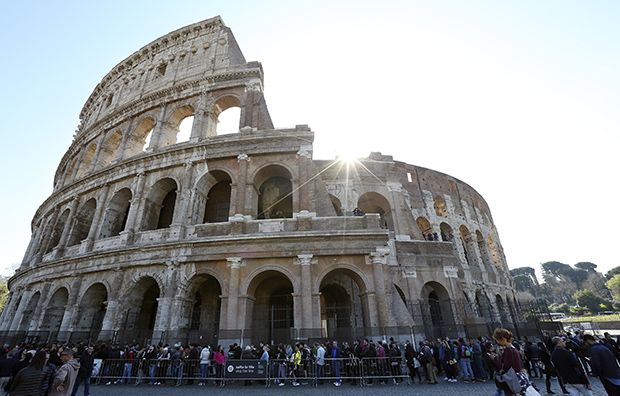A mixture of opportunism and good fortune has meant Italy has gone some way towards organising its finances in a market heavily influenced by the ECB’s QE programme.
Italy, the eurozone’s most indebted nation other than Greece, has taken to using syndication to good effect to term out its high levels of debt.
A succession of crises in 2011 and 2012 meant peripheral eurozone nations all saw their debt levels jump in a short period of time.
Italy’s debt-to-GDP ratio went from 115.4% in 2010 to 132.7% in 2015, behind only Greece (176.9%) in the single currency bloc.
Against this backdrop, its recent funding highlight was without question the €9bn 30-year bond printed in February this year, described by one banker as the “biggest duration event in European bond markets history”.
It was the largest syndicated deal at the tenor from any eurozone sovereign in at least five years, the size made possible by a mammoth book of €25.6bn.
“We’ve seen Spain get this sort of demand in the past, but not for a 30-year. To get €20bn-plus orders for a 30-year is super-impressive,” said one SSA syndicate banker.
Another said timing was the key. “Italy was the first one to come out with a long bond in a market that had just turned in favour of duration, so the timing was impeccable.”
An uncertain backdrop at the start of the year meant investors were wary of buying long-dated bonds. However, that sentiment changed, with ECB president Draghi hinting at further policy easing as soon as March.
Bankers praised the transaction’s execution, saying Italy was right to start at a cautious level before tightening in the face of the demand
“You don’t jeopardise a 30-year bond for a couple of basis points here and there. It can be a very complicated tenor; you just have to come at a price where there’s no discussion,” said a banker at the time.
If the promise of central bank stimulus helped on the 30-year, the reality of monetary policy easing aided Italy’s next trade.
With the ink barely dry on a rescue package for its banking sector, in April it brought a 20-year benchmark to similar effect, printing a €6.5bn September 2036 on a €17bn-plus book.
The storming result confirmed expectations that a strong bid for duration would trump concerns around its struggling banking sector, although it also came in a month when there were record levels of redemptions and the ECB increased asset purchases by €20bn a month to €80bn.
“It feels like January at the moment; it’s a perfect storm of factors making for an extremely conducive environment,” one SSA syndicate official told IFR at the time.
“I think people are right to be concerned that tighter spreads and political events such as Brexit and Spanish elections could disrupt the market in the months to come. This really is the window to take,” he said.
Mixed linkers
Italy enjoyed more mixed success in the index-linked sector. In October last year, it timed a 15-year to perfection, hitting a market that went soft soon after when growth and inflation expectations dipped.
It was able to print €3.5bn on demand that took bankers by surprise, with the issue more than two and half times subscribed and real money accounts returning in force to this part of the market.
“We went into it thinking it should work fine and a solid €3bn should be on the cards – we were really surprised by the strength of the demand and were able to print an extremely strong €3.5bn deal,” said a lead banker. “The whole thing seemed to come together effortlessly.”
In May this year, however, it raised eyebrows by bringing a syndicated inflation-linked bond to market at time when expectations for growth and inflation in the eurozone were still ebbing.
It printed a €3bn 0.10% May 2022 bond, surprising many by going for a short-dated linker at a time when most were expecting a long-dated conventional deal.
“I find it a bit unusual both in the choice of maturity and the choice of a linker. Many people are at the moment scratching their heads wondering if yields will ever rise again,” said a SSA syndicate official away from the deal. “If you are an investor, would you buy a five or six-year linker or buy something in the 20-year space and beyond?”
This was reflected in the final order book. It was in excess of €5.7bn but included €800m of joint lead manager orders and €1bn from the co-leads. When Italy priced its €3.5bn 2032, the book had topped €9.3bn with €1.375bn of JLM interest.
A lead banker agreed it was not an obvious trade to do but said syndication was necessary because the sovereign was establishing a new coupon cycle, with an Italian treasury official saying this approach made for a “more interactive process”.
“It’s not like a 50-year grab for duration, but it still worked because there’s still some demand for this product,” said the banker. “The ECB has said it is committed to pushing inflation up, so investors see value in it.”
The treasury official pointed out there has been a lot of supply in the long end recently and market risks exist.
This will be a factor for Italy to consider, given it has been tipped as a potential candidate for following France, Belgium and Spain into the 50-year tenor.
The country’s treasury wants to raise at least €2bn in a 50-year sale in the near future, two market sources told Reuters in May.
If it does bring a deal to market, it may have to contend with some political headlines of its own.
The country’s short and medium-term stability will be at risk later this year if it fails to push through constitutional reform aimed at simplifying policy-making, analysts at Deutsche Bank said.
They were referring to a crucial October referendum on reducing the size and influence of the Senate. A failure to vote through the reforms would bring the government’s position into question and compromise Italy’s ability to put reforms in place for the foreseeable future.
“Growth would likely remain unsatisfactory and the country would become vulnerable to shocks, above all when the ECB QE programme terminates,” the analysts said.
To see the digital version of this special report, please click here
To purchase printed copies or a PDF of this report, please email gloria.balbastro@thomsonreuters.com




